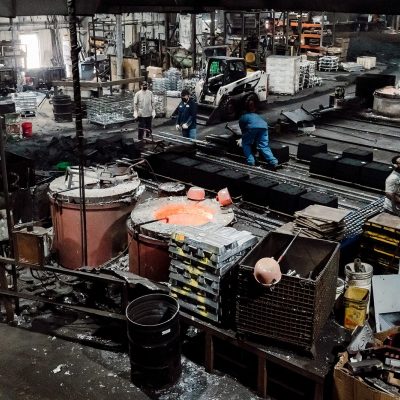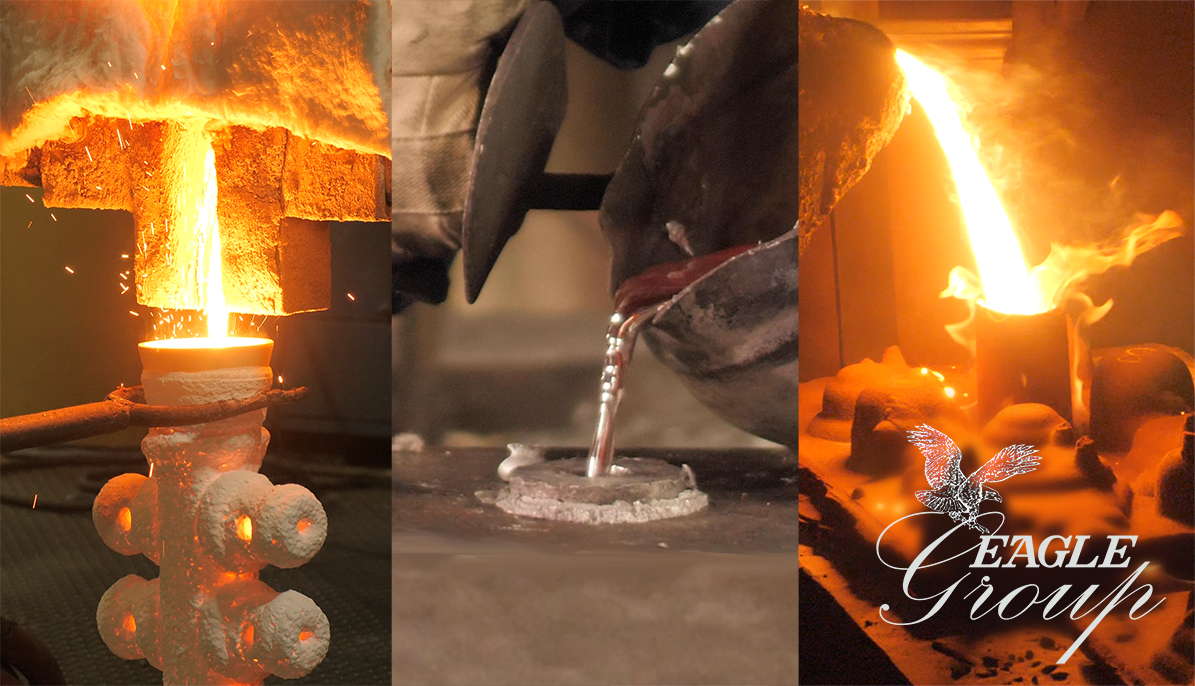A closer look at Aluminum Foundry processes and their remarkable casting results
Wiki Article
Recognizing the Metal Castings Process: A Comprehensive Guide for Beginners
The Metal Casting process is a basic method in making that changes molten steel into solid forms. Beginners have to comprehend the numerous techniques involved, such as sand casting and die casting. Recognizing the materials, layout concepts, and precaution is equally vital. Each aspect plays a critical role in accomplishing successful end results. As one navigates these details, the inquiry of how to enhance each action for improved outcomes comes to be progressively important.The Essentials of Steel Casting
Metal Casting has actually progressed over centuries, its basic concepts continue to be indispensable and consistent to the manufacturing process. At its core, Metal Casting involves the transformation of molten metal into strong objects with different methods. The process starts with the production of a mold, which defines the form of the end product. When the mold is prepared, metal is warmed to its melting point and put right into the tooth cavity. After cooling, the steel strengthens, taking the shape of the mold.There are a number of casting methods, consisting of sand spreading, investment spreading, and pass away spreading, each with one-of-a-kind advantages and applications. The selection of technique depends upon factors such as production quantity, material kind, and preferred precision. When cast, the end product might undertake extra procedures like machining or surface area therapy to accomplish the needed surface and requirements. Understanding these fundamentals is necessary for anyone curious about the field of Metal Casting.

Recognizing Materials Made Use Of in Steel Casting
Materials play a necessary duty in the Metal Casting process, influencing the last item's properties and efficiency. Different metals are made use of, including aluminum, steel, iron, and bronze, each offering unique features matched for specific applications. Light weight aluminum is corrosion-resistant and lightweight, making it suitable for automobile parts. Iron, specifically cast iron, is favored for its outstanding wear resistance and longevity. Steel provides high toughness and versatility, typically made use of in heavy equipment elements. Bronze, known for its deterioration resistance and machinability, is generally employed in marine applications.In addition to the steels, numerous casting products, such as sand, plaster, and ceramic, are made use of to produce molds. Sand casting, the most prevalent technique, utilizes silica sand due to its thermal security and capability to create elaborate shapes. Plaster and ceramic mold and mildews supply finer details but might require even more complicated procedures. The choice of materials directly influences the performance, price, and quality of the casting procedure.
The Design Process: From Concept to Blueprint
The design procedure in Metal Casting starts with the first concept development, where ideas are generated and assessed. This is followed by the application of CAD modeling techniques, enabling precise visualizations of the style. The blueprint finalization actions assure that all requirements are accurately documented for manufacturing.First Concept Development
First idea development marks a vital stage in the Metal Casting procedure, where concepts change into tangible styles. During this phase, designers team up with engineers and stakeholders to brainstorm and improve first ideas. They take into consideration factors such as capability, visual appeals, and manufacturability, making certain that the style meets the called for specs and efficiency standards. Illustrations and outlines are produced to picture the principles, permitting initial evaluations of feasibility and cost-effectiveness. This stage likewise involves determining products and prospective casting methods that straighten with the design objectives. Ultimately, initial idea growth lays the foundation for an extensive blueprint, leading the subsequent stages of the casting procedure and making sure an effective shift from concept to truth.CAD Modeling Techniques
Changing principles into accurate designs, CAD modeling methods play a crucial function in the Metal Casting procedure. These strategies use advanced software application to produce comprehensive three-dimensional designs that properly show the intended item. By utilizing tools such as parametric modeling, strong modeling, and surface area modeling, developers can adjust measurements and forms easily. CAD systems additionally help with simulation and evaluation, enabling the recognition of possible imperfections before manufacturing starts. This positive technique lowers material waste and optimizes the design for manufacturability. Additionally, CAD versions can be quickly modified, enabling fast iterations based upon comments. Fundamentally, CAD modeling works as the foundation of the style procedure, linking the gap in between initial ideas and the eventual production-ready styles.Plan Completion Steps
Complying with the development of detailed CAD models, the following stage entails plan completion, which is vital in converting digital designs into actionable prepare for manufacturing. This procedure begins with reviewing the CAD models for precision and compliance with specifications. As soon as verified, the measurements, resistances, and material specs are diligently described to guarantee clarity. Integrating notes and notes helps connect vital details pertaining to spreading processes, surface area coatings, and assembly demands. The completed plan undergoes a strenuous approval procedure, usually involving cooperation with engineers and manufacturing groups to address any kind of potential concerns. Besides revisions are made and authorizations obtained, the blueprint is formally released, functioning as the fundamental paper for the succeeding stages of Metal Casting, consisting of pattern making and mold and mildew design.The Metal Casting Techniques Described

Metal Casting methods incorporate a variety of methods utilized to form molten steel into preferred forms. These techniques differ according to the type of product, complexity of the style, and manufacturing volume. Sand spreading is just one of the most typical approaches, including the production of a mold from sand to hold the molten metal. Investment casting, or lost-wax spreading, enables for elaborate layouts by utilizing a wax pattern that is disappeared. Pass away casting uses high-pressure shot of liquified steel into a mold and mildew, suitable for mass manufacturing. Various other techniques consist of irreversible mold casting, which utilizes multiple-use mold and mildews, and centrifugal spreading, where rotational pressures aid in filling the mold. Each strategy has its applications and advantages, making it crucial for producers to pick the proper method based on their specific requirements and demands. Understanding these methods is important for anyone associated with the Metal Casting procedure.
Ending Up Procedures: Enhancing Your Casted Item

Completing procedures play an important role in enhancing the quality and look of casted items. Various surface therapy methods, such as polishing and coating, are used to boost resilience and appearances. In addition, top quality inspection techniques guarantee that the final item satisfies specified criteria and performance needs.
Surface Area Therapy Techniques
A variety of surface area therapy strategies play an important function in enhancing the top quality and longevity of casted items. These techniques consist visite site of techniques such as shot blasting, polishing, and coating. Shot blowing up properly eliminates surface imperfections, boosting the visual and useful features of the casting. Sprucing up offers a smooth finish, which is specifically important for ornamental applications and elements calling for very little rubbing. Covering strategies, such as electroplating or powder finishing, deal extra defense against corrosion and wear, guaranteeing toughness. Surface area treatments can enhance bond for succeeding procedures, such as paint or bonding. By employing these approaches, producers can attain exceptional surface area quality, which is critical for the performance and life-span of Metal Casting in numerous applications.Top Quality Evaluation Approaches
Efficient quality evaluation approaches are important for guaranteeing the stability and performance of casted discover here products after the completing procedures. Numerous techniques are employed to evaluate the quality of Metal Casting, including visual inspection, dimensional checks, and non-destructive testing (NDT) Aesthetic inspection permits the recognition of surface flaws, while dimensional checks assure that products meet specified tolerances. NDT approaches, such as ultrasonic screening and radiographic evaluation, give deeper insights right into interior honesty without damaging the castings. Additionally, mechanical testing, such as tensile and hardness examinations, reviews material buildings - Metal Castings. By employing a mix of these approaches, suppliers can enhance product top quality and reliability, ultimately resulting in higher client fulfillment and reduced production pricesSecurity Considerations in Metal Casting
While the Metal Casting process supplies many benefits, it additionally offers a series of safety and security hazards that must be very carefully taken care of. Workers in casting facilities are subjected to high temperature levels, molten metals, and hazardous materials, which can result in extreme injuries if correct precautions are not taken. Individual protective devices (PPE) such as heat-resistant gloves, deal with guards, and safety garments is important to lessen risks.In addition, the presence of fumes and dirt necessitates appropriate air flow systems to guarantee air top quality - Aluminum Castings. Regular training on security protocols is necessary for all staff members to acknowledge prospective dangers and respond properly. Emergency treatments should be developed, including fire security measures and first aid availability. Upkeep of devices and correct handling of materials further add to a more secure working setting. By prioritizing these safety factors to consider, Metal Casting procedures can secure their workforce and keep effective manufacturing procedures
Frequently Asked Questions
What Are the Environmental Influences of Metal Casting?
Metal Casting can lead to ecological impacts such as air and water contamination, resource exhaustion, and energy intake. Additionally, incorrect waste management and exhausts from factories add to eco-friendly disturbances and wellness dangers for neighboring communities.How Do I Choose the Right Steel for Spreading?
To choose the right metal for casting, one should think about aspects such as mechanical homes, corrosion resistance, thermal conductivity, and price. Evaluating the designated application and ecological conditions is essential for suitable choice.What Are the Typical Issues in Metal Casting?
Common defects in Metal Casting consist of porosity, shrinking, sand inclusion, and misruns. These concerns commonly arise from improper material choice, poor design, or flaws in the casting process, affecting the last item's top quality and efficiency.
Just How Can I Improve My Steel Casting Abilities?
To boost Metal Casting abilities, this post one should practice constantly, research spreading techniques, analyze previous jobs for flaws, look for feedback from skilled wheels, and constantly experiment with various materials and approaches to improve efficiency and understanding.What Is the Price of Starting a Steel Spreading Business?
Beginning a metal spreading business commonly calls for a first financial investment of $5,000 to $50,000, depending on devices, materials, and facility expenses. Aspects like place and range can substantially influence overall start-up expenditures.The Metal Casting procedure is a fundamental technique in manufacturing that changes molten steel right into solid types. Beginners should grasp the various methods involved, such as sand spreading and pass away spreading. There are several casting approaches, consisting of sand casting, financial investment casting, and pass away casting, each with special advantages and applications. Financial investment spreading, or lost-wax casting, permits for intricate styles by utilizing a wax pattern that is melted away. Other approaches consist of permanent mold casting, which utilizes recyclable molds, and centrifugal spreading, where rotational pressures aid in loading the mold.
Report this wiki page